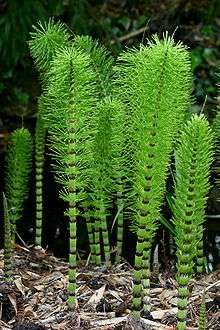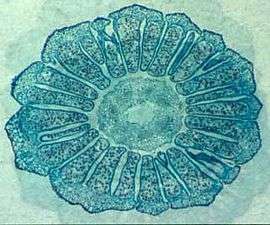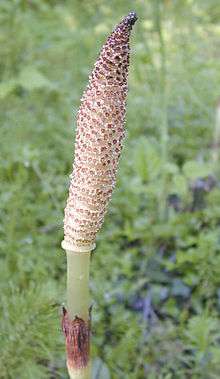Equisetidae
Equisetidae is one of the four subclasses of Polypodiopsida (ferns), a group of vascular plants with a fossil record going back to the Devonian. They are commonly known as horsetails.[2] They typically grow in wet areas, with whorls of needle-like branches radiating at regular intervals from a single vertical stem.
| Equisetidae | |
|---|---|
 | |
| Equisetum telmateia | |
| Scientific classification | |
| Kingdom: | Plantae |
| Clade: | Tracheophytes |
| Class: | Polypodiopsida |
| Subclass: | Equisetidae Warm. |
| Orders | |
| |
| Synonyms | |
|
See text. | |
The Equisetidae were formerly regarded as a separate division of spore plants and called Equisetophyta, Arthrophyta, Calamophyta or Sphenophyta. When treated as a class, the names Equisetopsida s.s. and Sphenopsida have also been used. They are now recognized as rather close relatives of the ferns (Polypodiopsida) of which they form a specialized lineage.[3] However, the division between the horsetails and the other ferns is so ancient that many botanists, especially paleobotanists, still regard this group as fundamentally separate at the higher level.
Description
The horsetails comprise photosynthesising, "segmented", hollow stems, sometimes filled with pith. At the junction ("node", see diagram) between each segment is a whorl of leaves. In the only extant genus Equisetum, these are small leaves (microphylls) with a singular vascular trace, fused into a sheath at each stem node. However, the leaves of Equisetum probably arose by the reduction of megaphylls, as evidenced by early fossil forms such as Sphenophyllum, in which the leaves are broad with branching veins.[4]
The vascular bundles trifurcate at the nodes, with the central branch becoming the vein of a microphyll, and the other two moving left and right to merge with the new branches of their neighbours.[5] The vascular system itself resembles that of the vascular plants' eustele, which evolved independently and convergently.[5] Very rapid internode elongation results in the formation of a pith cavity and a ring of carinal canals formed by disruption of the primary xylem. Similar spaces, the vallecular canals are formed in the cortex.[5] Due to the softer nature of the phloem, these are very rarely seen in fossil instances. In the Calamitaceae, secondary xylem (but not secondary phloem) was secreted as the cambium grew outwards, producing a woody stem, and allowing the plants to grow as high as 10m. All extant species of Equisetum are herbaceous, and have lost the ability to produce secondary growth.[5]
The underground parts of the plants consist of jointed rhizomes, from which roots and aerial axes emerge. The plants have intercalary meristems in each segment of the stem and rhizome that grow as the plant gets taller. This contrasts with the seed plants, which grow from an apical meristem - i.e. new growth comes only from growing tips (and widening of stems).
Horsetails bear cones (technically strobili, sing. strobilus) at the tips of some stems. These cones comprise spirally arranged sporangiophores, which bear sporangia at their edges, and in extant horsetails cover the spores externally - like sacs hanging from an umbrella, with its handle embedded in the axis of the cone. In extinct groups, further protection was afforded to the spores by the presence of whorls of bracts - big pointed microphylls protruding from the cone.
The extant horsetails are homosporous, but extinct heterosporous species such as Calamostachys casheana appear in the fossil record.[6] The sporangia open by lateral dehiscence to release the spores. The spores bear characteristic elaters, distinctive spring-like attachments which are hygroscopic: i.e. they change their configuration in the presence of water, helping the spores move and aiding their dispersal.
N = node,
I = internode,
B = branch in whorl,
L = fused microphylls


Taxonomy
Classification
The horsetails and their fossil relatives were long been recognized as distinct from other seedless vascular plants, such as the ferns (Polypodiopsida).[7] Before the advent of modern molecular studies, the relationship of this group to other living and fossil plants was considered problematic.[8] Because of their unclear relationships, the rank botanists assigned to the horsetails varied from order to division. When recognized as a separate division, the literature uses many possible names, including Arthrophyta,[8] Calamophyta, Sphenophyta,[1][9] or Equisetophyta. Other authors regarded the same group as a class, either within a division consisting of the vascular plants or, more recently, within an expanded fern group. When ranked as a class, the group has been termed the Equisetopsida[10] or Sphenopsida.[5]
Modern phylogenetic analysis, back to 2001, demonstrated that horsetails belong firmly within the fern clade of vascular plants.[11][12] Smith et al. (2006) carried out the first higher-level pteridophyte classification published in the molecular phylogenetic era, and considered the ferns (monilophytes), to comprise four classes, with the horsetails as class Equisetopsida sensu stricto.[3] (This distinction is necessary because of the alternative usage of Equisetopsida sensu lato as a synonym for all land plants (Embryophyta) with rank of class.[13]) Chase and Reveal (2009) treated the horsetails as subclass Equisetidae of class Equisetopsida sensu lato. The consensus classification produced by the Pteridophyte Phylogeny Group in 2016 also places horsetails in the subclass Equisetidae, but in the class Polypodiopsida (ferns broadly defined).[2]
Phylogeny
The following diagram shows a likely phylogenic relationship between subclass Equisetidae and the other fern subclasses according to the Pteridophyte Phylogeny Group.[2]
| Polypodiopsida |
| ||||||||||||||||||
A 2018 study by Elgorriaga et al. suggests the relationships within the Equisetidae are as shown in the following cladogram.[14]
| |||||||||||||||||||||||||||||||
According to the study, the age of the crown group of Equisetum dates at least to the Early Cretaceous, and most probably up to the Jurassic.[14]
Subdivision
Subclass Equisetidae contains a single extant order, Equisetales. This order consists of a single monotypic family, Equisetaceae, with one genus Equisetum. Equisetum has about 20 species.[12][2]
Fossil record
The extant horsetails represent a tiny fraction of horsetail diversity in the past. There were three orders of the Equisetidae. The Pseudoborniales first appeared in the late Devonian.[1] The Sphenophyllales were a dominant member of the Carboniferous understory, and prospered until the mid and early Permian. The Equisetales existed alongside the Sphenophyllales, but diversified as that group disappeared into extinction, gradually dwindling in diversity to today's single genus Equisetum.
The organisms first appear in the fossil record during the late Devonian,[1] a time when land plants were undergoing a rapid diversification, with roots, seeds and leaves having only just evolved. (See Evolutionary history of plants) However, plants had already been on the land for almost a hundred million years, with the first evidence of land plants dating to 475 million years ago.[15]
References
- Taylor, T.N. & Taylor., E.L. (1993). The biology and evolution of fossil plants. Englewood Cliffs, NJ: Prentice Hall. pp. 303–305. ISBN 978-0-13-651589-0.
- Pteridophyte Phylogeny Group I (November 2016), "A community-derived classification for extant lycophytes and ferns", Journal of Systematics and Evolution, 54 (6): 563–603, doi:10.1111/jse.12229CS1 maint: ref=harv (link)
- Smith, A.R.; Pryer, K.M.; Schuettpelz, E.; Korall, P.; Schneider, H. & Wolf, P.G. (2006). "A classification for extant ferns" (PDF). Taxon. 55 (3): 705–731. doi:10.2307/25065646. JSTOR 25065646. Archived from the original (PDF) on 2008-02-26. Retrieved 2019-10-28.
- Rutishauser, R. (1999). "Polymerous leaf whorls in vascular plants: Developmental morphology and fuzziness of organ identities". International Journal of Plant Sciences. 160 (6): 81–103. doi:10.1086/314221. JSTOR 10.1086/314221. PMID 10572024.
- Stewart, W.N. & Rothwell, G.W. (1993). Paleobotany and the evolution of plants (2nd ed.). Cambridge: Cambridge University Press. ISBN 978-0-521-38294-6.
- Bower, F.O. (1959) [1935]. The origin of the land flora, a theory based upon the facts of alternation. New York: Hafner publishing Co. p. 381.
- Eames, A.J. (1936). Morphology of vascular plants (Lower Groups). New York and London: McGraw-Hill Book Company. pp. 110–115.
- Bold, H.C.; Alexopoulos, C.J.; Delevoryas, T. (1987). Morphology of Plants and Fungi (5th ed.). New York: Harper-Collins. pp. 371–387, 478, 506–514. ISBN 978-0-06-040839-8.
- Gifford, E.M.; Foster, A.S. (1988). Morphology and evolution of vascular plants (3rd ed.). New York: W. H. Freeman and Company. pp. 175–207. ISBN 978-0-7167-1946-5.
- Kenrick, P.; Crane, P.R. (1997). The Origin and early diversification of land plants: A cladistic study. Washington, D. C.: Smithsonian Institution Press. pp. 241–242. ISBN 978-1-56098-730-7.
- Pryer, K.M.; Schneider, H.; Smith, A.R.; Cran, R.; Wolf, P.G.; Hunt, J.S.; Sipes, S.D. (2001). "Horsetails and ferns are a monophyletic group and the closest living relatives to seed plants" (PDF). Nature. 409 (6820): 618–621. Bibcode:2001Natur.409..618S. doi:10.1038/35054555. PMID 11214320. Archived from the original (PDF) on 2009-09-02.
- Christenhusz, Maarten J.M. & Chase, Mark W. (2014). "Trends and concepts in fern classification". Annals of Botany. 113 (4): 571–594. doi:10.1093/aob/mct299. PMC 3936591. PMID 24532607.CS1 maint: ref=harv (link)
- Chase, Mark W. & Reveal, James L. (2009), "A phylogenetic classification of the land plants to accompany APG III", Botanical Journal of the Linnean Society, 161 (2): 122–127, doi:10.1111/j.1095-8339.2009.01002.xCS1 maint: ref=harv (link)
- Elgorriaga, A.; Escapa, I.H.; Rothwell, G.W.; Tomescu, A.M.F.; Cúneo, N.R. (2018). "Origin of Equisetum: Evolution of horsetails (Equisetales) within the major euphyllophyte clade Sphenopsida". American Journal of Botany. 105 (8): 1286–1303. doi:10.1002/ajb2.1125. PMID 30025163.
- Wellman, C.H.; Osterloff, P.L.; Mohiuddin, U. (2003). "Fragments of the earliest land plants" (PDF). Nature. 425 (6955): 282–285. Bibcode:2003Natur.425..282W. doi:10.1038/nature01884. PMID 13679913.
External links
![]()
| Wikimedia Commons has media related to Equisetopsida. |